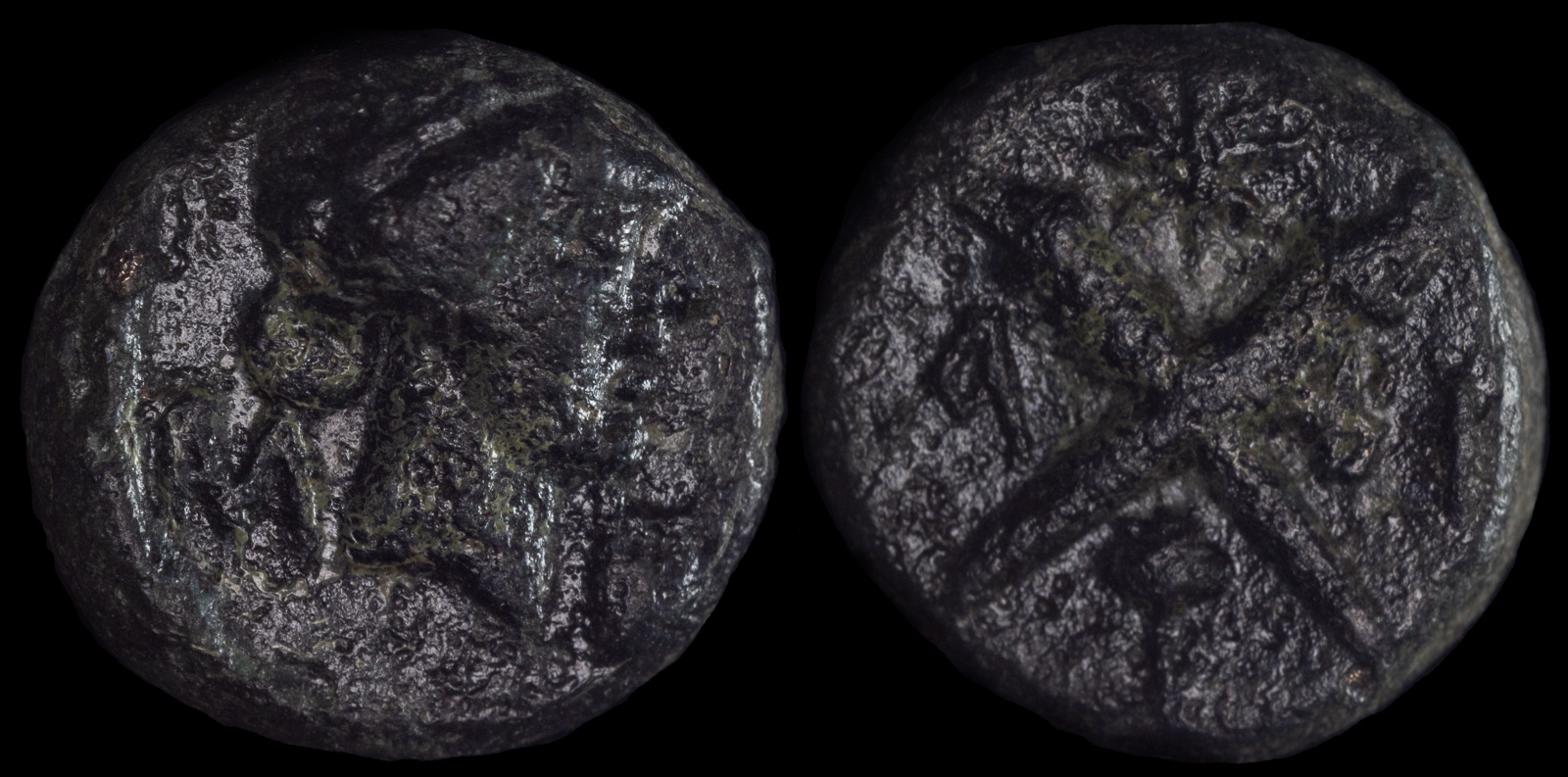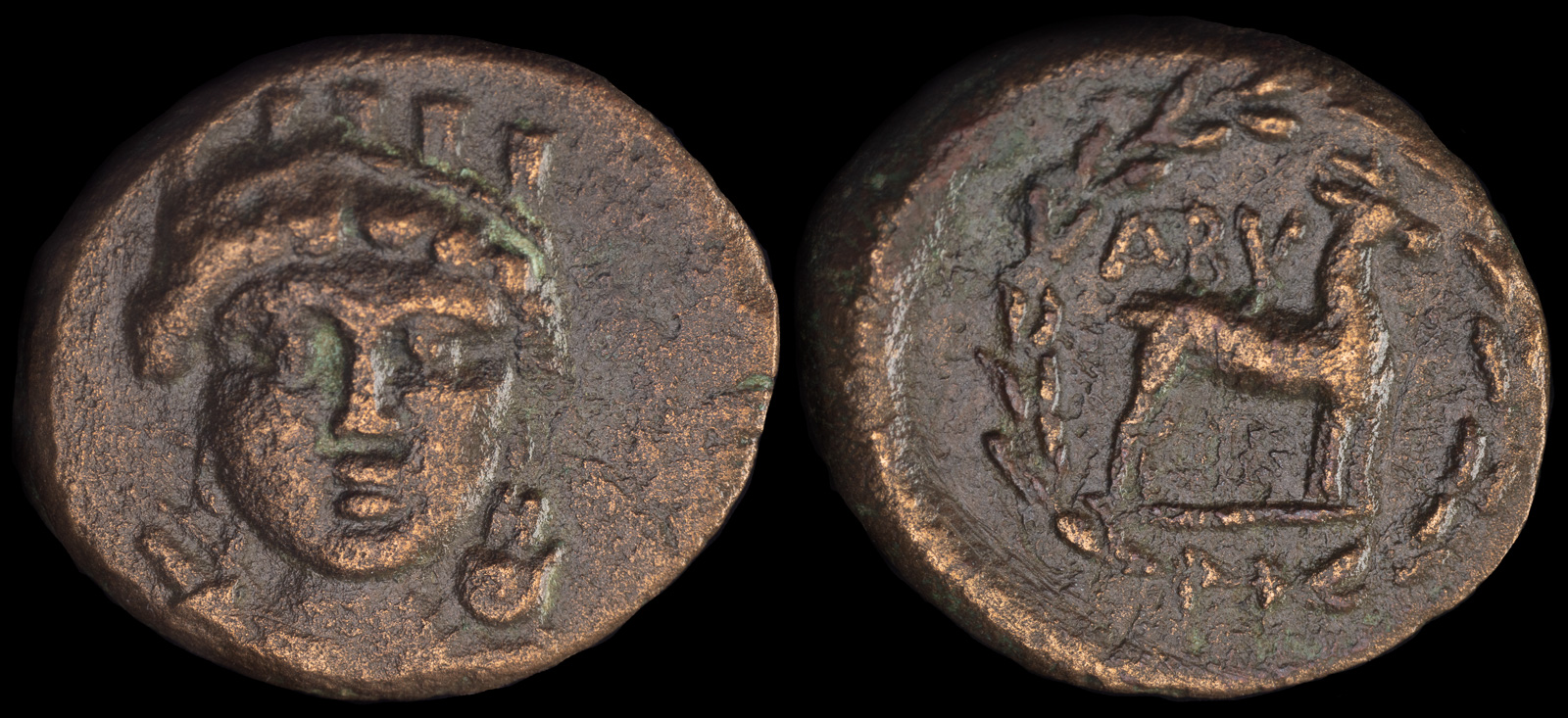
Troas, Abydos
Circa 4th-3rd centuries BCE
Æ 7.23g, 20mm, 12h
Laureate head of Apollo to right
Eagle standing to right; ABY to left, facing bust of Artemis to right.
SNG Copenhagen 25.
As a key crossing site on the Hellespont, nearly every historic figure involved between Asia and Europe in ancient times spent time at Abydos. The Persians twice crossed from here to Sestos, first against the Persians and again by Xerxes in his famed invasion of Greece.
Xenophon details the various intrigues between the Spartans and the Persians (notably Pharnabazos) in his Hellenika and Alexander the Great himself crossed here. Memnon of Rhodes besieged the city at one point. Lysimachos crossed here to attack Antigonos Monophthalmos, who was relieved by his son Demetrios.
The city now lies in a restricted military zone, though very few ruins remain.

Abydos, Troas
320-200 BCE
Æ 12mm, 2,11g
Obv: Laureate head of Artemis right, bow and quiver over shoulder.
Rev: A – BY. Crossed torches; star above; poppy head below.
BMC 44; Coll. Weber 5278
While the above coin is not super-rare, it’s definitely not one of the more common Abydos releases, and I was curious about the symbolism concerning the different elements depicted. To investigate, I took a bit different approach. I asked question to ChatGPT, then when it gave me something interesting, I requested a source. I then validated that the source agreed with the statement.
I’ll start with the obverse, which depicts Artemis. Granted, I don’t think this is an image one would pick out of a lineup, but Artemis was heavily associated with Abydos throughout its coinage, so she makes sense. Interestingly, there is no evidence in either archeology or historical references to a temple to Artemis in Abydos (ChatGPT made an error here stating the temple to Artemis Amarysia was in Abydos, but it was instead in Euboia), but there is widespread evidence for a cult to Artemis in the Troad region.
A paper by Stolba and Peter discusses the cult and in truth, in a bit of a circular dependency, ancient coinage is the primary source. Not just Abydos but many cities in the region featured her. Stolba and Peter also mention that the cult appeared to be stronger during Roman times, though this coin comes obviously earlier (though how much earlier is uncertain). The specific cult most popular was that of Artemis Ephesia, for whom cult-statues have been found. Intriguingly, the map provided by Stolba and Peter shows that Abydos was a bit of an outlier, with her worship primarily centered in Ionia. The paper mentions Abydos specifically, where the images of Artemis differed from those found around Ephesos, but where numerous evidence makes it clear that she was favored in Abydos.
Moving on, I at first dismissed the eight-rayed star found on so many other coins, but it’s symbolism here is deliberate. While it didn’t have a singular meaning across all cultures, it often symbolized life and fertility and was therefore heavily associated with Aphrodite. The story of her worship is best told by Kleanthos via Strabo.
There is also a temple of Aphrodite the Prostitute (πόρνη) at Abydus, as Pamphilus asserts:- “For when all the city was oppressed by slavery, the guards in the city, after a sacrifice on one occasion (as Cleanthus relates in his essays on Fables), having got intoxicated, took several courtesans; and one of these women, when she saw that the men were all fast asleep, taking the keys, got over the wall, and brought the news to the citizens of Abydus. And they, on this, immediately came in arms, and slew the guards, and took possession of the walls, and recovered their freedom; and to show their gratitude to the prostitute, they built a temple to Aphrodite the Prostitute.”
It seems likely, therefore, that the star on this coin symbolized Aphrodite, whose temple was well known. My suspicion is there aren’t too many coins with a reference to both Artemis and a prostitute.
The poppy generally symbolized both death and sleep, since poppies were used to put Persephone to sleep as she traveled to and from the underworld (in other legends, it was to aid Demeter in sleeping when she was mourning). They have been found on pottery in the region, though the specific religious meaning is poorly understood. Certainly, the flowers were widespread in the area. What I wonder is the juxtaposition of these two elements across the coin, with the star denoting life, while the poppy denotes death.
The meaning of the crossed torches is even more difficult, and the following possibilties were presented:
Symbolizing death or mourning, perhaps in commemoration of a deceased ruler
Reference to a mystery cult
As a symbol of divine or regal authority
Recognizing a victory or triumph
Signifying unity
In terms of mystery cults, there was a well-known cult to Osiris in Abydos. It’s referred to by Eusebios.
For to say that he will batter the heavens, and publish the secrets of Isis, and show the forbidden mystery at Abydos, and stop the sacred boat, and scatter the limbs of Osiris for Typhon.
Torches were part of the procession for Osiris. For those unacquainted like myself, the basic legend was that Osiris was murdered by his brother Seth and his body scattered. Isis then played an ancient version of “Operation” and found all his parts except for his penis, because she only had the PG version of the game. She then put him back together and reanimated him.
In the procession in Osiris’ honor, torches were used to light the path back into the afterlife. My suspicion is these torches refer to this practice.
Therefore, on the reverse we have references to the three main religious practices at Abydos – the cult of Artemis, the sanctuary to Aphrodite the Prostitute, and the cult of Osiris.
The last question involves the ‘M’ on the obverse. These are mostly attributed to mint marks, but I’m growing to feel they signify rulers and tyrants more often than proposed. From a quick search, not all copies of this coin contained the ‘M’. They either have an ‘M’, or nothing. While a few tyrants are known from around the time of Philip II, we have practically no history of the city from 350 BCE to 200 BCE, outside of Alexander’s visit and occupation. I agree with the attribution, though, that this coin was unlikely to come from 350 BCE to 320 BCE, and it’s nearly impossible to narrow it down further.
I believe this signifies someone of importance in the city, perhaps a tyrant, but I haven’t been able to locate any records from this period indicating the political situation, so we’ll probably never know.
Overall, this is an extremely interesting coin in my opinion that tells a lot about Abydos.

Troas, Abydos.
3rd century BCE
Ae 6.84g, 20mm
Obv: Turreted and draped bust of Artemis facing slightly right, bow and quiver over shoulder.
Rev: ABY. Stag standing right within wreath.
SNG Copenhagen 48; SNG von Aulock 1450
Abydos founded by settlers from Miletos.
Abydos occupied by Persia.
Antandros removes its Persian garrison with the help of Peloponnesian troops from Abydos.
May
408 BCE
Abydos attacked by Athens but repelled by Pharnabazos.
Anaxabios replaces Deryklidas as head of Abydos.
Anaxabios of Abydos is ambushed and killed by the Athenian general Iphikrates.
Antalkidas of Sparta lays waste to Tenedos and then continues to Abydos.
Peace of Antalkidas, arranged by Artaxerxes II, is signed in Susa, ending the Corinthian War. Abydos, Aigai, Kalchedon, Kaunos, Klazomenai, Kyzikos, Parion, Samos, and Adramytteion become part of the Persian Empire.
Tyrant Philiskos rules Abydos.
Abydos comes under the tyrant Iphiades.
Abydos besieged by the Macedonian general Parmenion under Philip II.
Abydos is besieged by Memnon of Rhodes, forcing Parmenion to give up his siege of Pitane.
Alexander the Great crosses from Sestos to Abydos. He then visits Troy and returns to Abydos. On his way, he sacrifices at the tomb of Achilles at Achilleion.
June 30
Partition of Babylon. Abydos and Adramytteion come under control of Leonnatos. Egypt with Alexandria and Gaza are under Ptolemy. Baktria comes under Seleukos I Nikator. Asandros obtains Caria. Laomedon receives Koele-Syria.
Partition of Triparadisos. Abydos is given to Arrhidaios. Susa goes to Antigenes. Antipater is left in charge of Macedonia and is entrusted with Alexander IV and Philip III. Asandros is confirmed with Caria. Kleitos the White receives Lydia, replacing Menander. Laomedon is confirmed as satrap of Koele-Syria. Peithon is confirmed in Kophen. Seleukos receives Babylon.
Abydos besieged by Lysimachos.
Lysimachos defeated at the Battle of Coropedion. Adramytteion, Ainos, and Abydos come under control of the Seleukid Empire. Ephesos returns to its original name.
Abydos and Ephesos conquered by Ptolemy III of Egypt.
Treaty of Apamea. Euromos, Laodikeia ad Lykon, Sestos, and Abydos returned to the Kingdom of Pergamon.